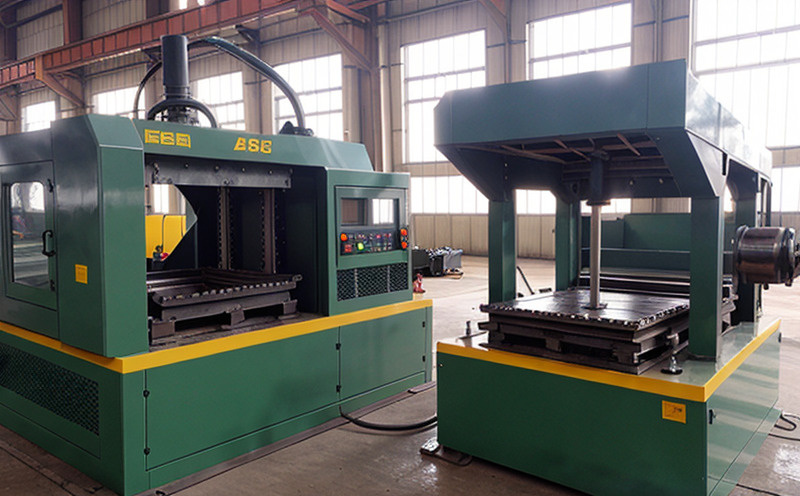ASTM E2218 Forming Limit Curve Testing of Sheet Materials
The ASTM E2218 standard specifies a method for determining the forming limit curve (FLC) of sheet materials used in industrial manufacturing and processing. The FLC is critical as it delineates the boundary between formable and non-formable regions, thus providing essential information for designing parts that can withstand high strain rates without tearing or cracking.
The testing procedure involves subjecting a sample to controlled tensile deformation until failure at various levels of strain. The data collected from these tests are used to plot the FLC, which is then used by engineers and designers to optimize part design and manufacturing processes. This ensures that materials are utilized efficiently while minimizing waste and cost.
The ASTM E2218 test is particularly important in industries such as automotive, aerospace, and electronics, where high-strength alloys like steel, aluminum, and titanium are commonly used. The FLC provides insights into how these materials behave under different conditions, helping manufacturers to select the most appropriate material for a given application.
The testing process begins with the preparation of samples cut from the sheet material to be tested. These samples should have uniform thickness and mechanical properties to ensure accurate results. Once prepared, they are placed in a tensile testing machine that applies controlled forces to deform them until failure. The deformation is monitored using strain gauges or other displacement measurement devices.
The key steps in the ASTM E2218 process include:
- Sample preparation
- Tensile testing under controlled conditions
- Data collection and analysis
- Plotting of the FLC curve
The resulting FLC provides a clear indication of the material's formability limits. This information is invaluable for designers who need to balance strength requirements with processability in their part designs.
The ASTM E2218 method ensures that materials used in manufacturing processes are optimized for both performance and cost-effectiveness, leading to more efficient production lines and reduced waste. By understanding the FLC of a material, manufacturers can tailor their processes to maximize the use of raw materials while minimizing defects.
Understanding the FLC is not just about compliance; it’s also about innovation. Engineers can leverage this knowledge to develop new alloys or modify existing ones to improve formability without compromising strength. This leads to better-performing parts, which in turn contribute to safer and more reliable products across various sectors.
The ASTM E2218 standard is widely recognized for its accuracy and reliability, making it an industry benchmark. Compliance with this standard ensures that materials used in critical applications meet the highest quality standards, enhancing product safety and performance.
Scope and Methodology
The ASTM E2218 standard provides a comprehensive framework for determining the forming limit curve of sheet materials. The scope of this test is broad enough to cover various types of sheet metals, including those used in industries such as automotive, aerospace, and electronics.
The methodology involves several key steps:
- Sample preparation: Uniform samples are cut from the sheet material to be tested. These samples should have consistent mechanical properties and thicknesses.
- Tensile testing: The samples are placed in a tensile testing machine, which applies controlled forces until failure. Strain gauges or other displacement measurement devices monitor the deformation process.
- Data collection and analysis: The collected data is used to plot the FLC curve, which shows the relationship between strain and stress up to the point of failure.
The test provides a clear indication of the material's formability limits. This information is crucial for designers who need to balance strength requirements with processability in their part designs.
The ASTM E2218 standard ensures that materials used in manufacturing processes are optimized for both performance and cost-effectiveness, leading to more efficient production lines and reduced waste. By understanding the FLC of a material, manufacturers can tailor their processes to maximize the use of raw materials while minimizing defects.
The test results are reported according to the ASTM E2218 specifications, which include the FLC curve, along with any relevant data from the testing process. This ensures that all stakeholders have access to accurate and reliable information about the material's formability limits.
Industry Applications
- Automotive: Ensuring high-strength steel parts are formable without defects during manufacturing processes.
- Aerospace: Determining the formability of aluminum alloys in critical components like engine parts and structural elements.
- Electronics: Optimizing the use of thin-gauge copper and aluminum for printed circuit boards and other electronic components.
- Machinery Manufacturing: Ensuring that metal sheets used in the construction of heavy machinery are formable to meet design specifications.
The ASTM E2218 test is essential for industries where high-strength alloys are commonly used. The FLC provides insights into how these materials behave under different conditions, helping manufacturers to select the most appropriate material for a given application.
Environmental and Sustainability Contributions
The ASTM E2218 forming limit curve testing contributes significantly to environmental sustainability by ensuring that materials are used efficiently in manufacturing processes. By optimizing part design using the FLC, manufacturers can minimize waste and reduce energy consumption during production.
This optimization leads to a reduction in raw material usage, which is particularly important for industries like automotive and aerospace where high-strength alloys are commonly used. The FLC ensures that materials are utilized effectively while maintaining product quality and safety standards.
Additionally, the ASTM E2218 test helps manufacturers comply with environmental regulations by ensuring that they use materials in a way that minimizes their carbon footprint. By reducing waste and optimizing production processes, industries can contribute to global efforts to reduce greenhouse gas emissions.





